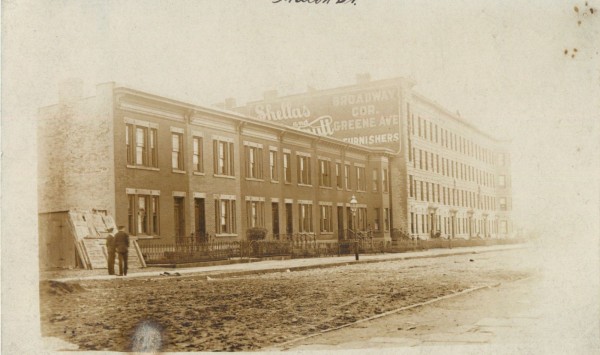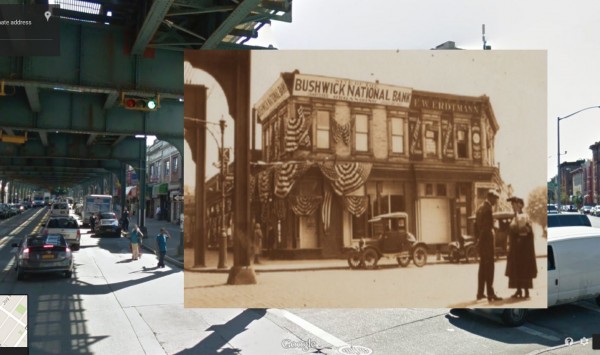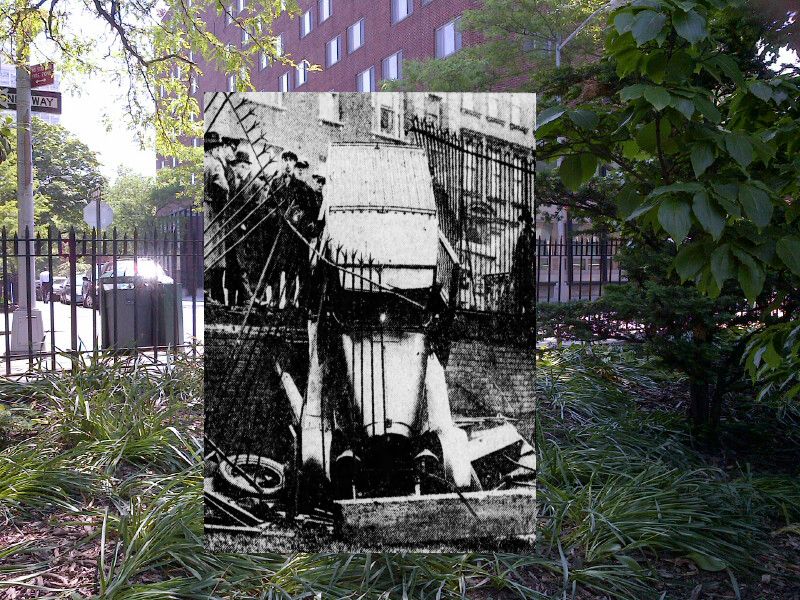THE CHANGING FACE OF MACON STREET (1908)

******************************************************************************************************************************** Brownstone Detectives investigates the history of our clients’ homes. The story you are about to read was composed from research conducted in the course of one of those investigations. Do you know the history of YOUR house? ******************************************************************************************************************************** While researching the history a local brownstone, we located an old postcard of a street in Bedford-Stuyvesant. The sepia paper photograph gives an idea of the innate promise of the neighborhood back in 1908 as it was still being built up with new brownstones, limestones, and rowhouses. That picture postcard, featured above, shows a stretch of Macon Street – replete with newly built rowhouses – that starts at the back of the Saratoga Library on Thomas S. Boyland Street (then, it was Hopkinson Avenue), and ends about halfway down the block before reaching a row of barrel-fronted 2-family houses and the one-time parking garage at the corner of Saratoga Avenue (now the Shirley Chisholm Day Care Center). Interestingly, this part of Macon Street still had its dirt (mud on rainy days) street as late as 1908. Residents of the area had been complaining to the City of Brooklyn (by 1908, the borough of Brooklyn) since the 1890s about the slow pace of street paving in the district. Home building had gone on at such a fast clip during this period that the city had struggled to keep up with the builders. The houses that are the focal point of the snapshot were the first put up on the block – what […]
THE “IMPOSING” VIEW FROM OCEAN HILL (1848)
******************************************************************************************************************************** Brownstone Detectives investigates the history of our clients’ homes. The story you are about to read was composed from research conducted in the course of one of those investigations. Do you know the history of YOUR house? ******************************************************************************************************************************** Before there was Ocean Hill—the Bedford-Stuyvesant neighborhood—there was Ocean Hill—the section of Green-Wood Cemetery. Whether one influenced the other is lost to the ages. What is clear, however, is that both locations got their names from a geographical point from which a body of water could clearly be viewed. “At this point, now known as Ocean Hill,” described a contributor (whose pen-name, revealingly, was Investment) in an edition of the Brooklyn Daily Eagle published just a few years before the Civil War began, “we have reached the highest point on the avenue (Fulton Street) and the most commanding elevation of ground in the city; and which, for grandeur, beauty and variety of its scenery, cannot be surpassed. “The ocean view,” Investment continued, “is especially grand and imposing.” Investment, whose contribution to the paper existed as a thinly veiled promotional piece for Brooklyn, was describing the “advance in the value of Brooklyn real estate.” From Fulton Ferry he advanced down Fulton Avenue to “gather such information as will enable the public to form an intelligent estimate as to the present and prospective value of property on and near this great thoroughfare.” “At this point Fulton avenue is distant but a few hundred feet from Atlantic avenue on the south, and Broadway on […]
WHEN BUSHWICK MET OCEAN HILL (1923)

******************************************************************************************************************************** Brownstone Detectives investigates the history of our clients’ homes. The story you are about to read was composed from research conducted in the course of one of those investigations. Do you know the history of YOUR house? ******************************************************************************************************************************** “Ocean Hill” was still settling softly into the Brooklyn lexicon of place names as a working class suburb in 1923. Bushwick, on the other hand, was already very well-known in the borough for its German breweries and beer gardens. But where the two met – and they met, all right – there were SPARKS! (…or maybe a bank or real estate office….) This snapshot was taken at the intersection of Broadway and Hopkinson Avenue (later to be renamed Thomas S. Boyland Street). The building there on the corner in 1923 held the Bushwick National Bank and Frederick W. Erdtmann’s real estate offices. The Bushwick National Bank came into existence the same year that this photograph was taken – probably the reason for the photograph and the patriotic bunting all around the building; the bank ended up merging with the Globe Exchange Bank in 1929, and so had a short life of about six years. Frederick W. Erdtmann, a realtor who lived at 868 Macon Street and then above his real estate offices in this building, had filed for bankruptcy in 1913 before this photo was taken. He was back in the real estate business by 1919 and did well for himself in the 1920s. Who the old woman and the young […]
A PROHIBITION WRECK ON ORANGE ST (1922)

******************************************************************************************************************************** Brownstone Detectives investigates the history of our clients’ homes. The story you are about to read was composed from research conducted in the course of one of those investigations. Do you know the history of YOUR house? ******************************************************************************************************************************** “Tearing through Orange st. with the throttle wide open, in the early hours this morning, a big limousine of expensive make crashed into an electric light pole at the foot of the street, ricocheted against a fire hydrant which it completely demolished, continued on its course and crashed through an eight-foot picket fence.” A flirtation at a dance, a stolen vehicle, a crash, the removal of a set of license plates, and a hasty departure from the scene of the accident was further described in the 12 December 1922 newspaper article. “CRASH WAKENS HEIGHTS” “A blood-stained hand pushed open the door of the limousine. Two gory men stepped out,” wrote the reporter. The two men “then turned and assisted a woman out of the car. They climbed over the wall to the street and stood huddled in a little group as if debating what to do.” After a few minutes of dazed waiting, the three crash victims walked quickly up Orange Street. Then, a few minutes later, one of the men was observed returning and making “a vain effort to wrench the rear license plate from the car.” All that he succeeded in doing, though, was leaving “a number of bloody but well-defined fingerprints on the license number.” A WOMAN APPEARS […]